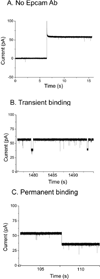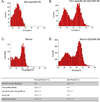Engineered nanopore of Phi29 DNA-packaging motor for real-time detection of single colon cancer specific antibody in serum
- PMID: 24152066
- PMCID: PMC3915501
- DOI: 10.1021/nn404435v
Engineered nanopore of Phi29 DNA-packaging motor for real-time detection of single colon cancer specific antibody in serum
Abstract
The ingenious design of the bacterial virus phi29 DNA packaging nanomotor with an elegant and elaborate channel has inspired its application for single molecule detection of antigen/antibody interactions. The hub of this bacterial virus nanomotor is a truncated cone-shaped connector consisting of 12 protein subunits. These subunits form a ring with a central 3.6-nm channel acting as a path for dsDNA to enter during packaging and to exit during infection. The connector has been inserted into a lipid bilayer. Herein, we reengineered an Epithelial Cell Adhesion Molecule (EpCAM) peptide into the C-terminal of nanopore as a probe to specifically detect EpCAM antibody (Ab) in nanomolar concentration at the single molecule level. The binding of Abs sequentially to each peptide probe induced stepwise blocks in current. The distinctive current signatures enabled us to analyze the docking and undocking kinetics of Ab-probe interactions and determine the Kd. The signal of EpCAM antibody can be discriminated from the background events in the presence of nonspecific antibody or serum. Our results demonstrate the feasibility of generating a highly sensitive platform for detecting antibodies at extremely low concentrations in the presence of contaminants.
Figures






Similar articles
-
Fingerprinting of Peptides with a Large Channel of Bacteriophage Phi29 DNA Packaging Motor.Small. 2016 Sep;12(33):4572-8. doi: 10.1002/smll.201601157. Epub 2016 Jul 20. Small. 2016. PMID: 27435806 Free PMC article.
-
Real-time sensing and discrimination of single chemicals using the channel of phi29 DNA packaging nanomotor.ACS Nano. 2012 Apr 24;6(4):3251-61. doi: 10.1021/nn3001615. Epub 2012 Apr 9. ACS Nano. 2012. PMID: 22458779 Free PMC article.
-
Channel size conversion of Phi29 DNA-packaging nanomotor for discrimination of single- and double-stranded nucleic acids.ACS Nano. 2013 Apr 23;7(4):3315-23. doi: 10.1021/nn400020z. Epub 2013 Mar 25. ACS Nano. 2013. PMID: 23488809 Free PMC article.
-
"Push through one-way valve" mechanism of viral DNA packaging.Adv Virus Res. 2012;83:415-65. doi: 10.1016/B978-0-12-394438-2.00009-8. Adv Virus Res. 2012. PMID: 22748815 Review.
-
Translation of the long-term fundamental studies on viral DNA packaging motors into nanotechnology and nanomedicine.Sci China Life Sci. 2020 Aug;63(8):1103-1129. doi: 10.1007/s11427-020-1752-1. Epub 2020 Jun 29. Sci China Life Sci. 2020. PMID: 32617827 Review.
Cited by
-
Fingerprinting of Peptides with a Large Channel of Bacteriophage Phi29 DNA Packaging Motor.Small. 2016 Sep;12(33):4572-8. doi: 10.1002/smll.201601157. Epub 2016 Jul 20. Small. 2016. PMID: 27435806 Free PMC article.
-
Single-Molecule Protein Detection in a Biofluid Using a Quantitative Nanopore Sensor.ACS Sens. 2019 Sep 27;4(9):2320-2326. doi: 10.1021/acssensors.9b00848. Epub 2019 Aug 21. ACS Sens. 2019. PMID: 31397162 Free PMC article.
-
A highly sensitive nanopore platform for measuring RNase A activity.Talanta. 2024 Aug 15;276:126276. doi: 10.1016/j.talanta.2024.126276. Epub 2024 May 22. Talanta. 2024. PMID: 38796995 Free PMC article.
-
Single pore translocation of folded, double-stranded, and tetra-stranded DNA through channel of bacteriophage phi29 DNA packaging motor.Biomaterials. 2015;53:744-52. doi: 10.1016/j.biomaterials.2015.02.104. Epub 2015 Mar 27. Biomaterials. 2015. PMID: 25890769 Free PMC article.
-
Advanced Nanoscale Approaches to Single-(Bio)entity Sensing and Imaging.Biosensors (Basel). 2018 Oct 26;8(4):100. doi: 10.3390/bios8040100. Biosensors (Basel). 2018. PMID: 30373209 Free PMC article. Review.
References
-
- Neher E, Stevens CF. Conductance Fluctuations and Ionic Pores in Membranes. Annu. Rev. Biophys. Bioeng. 1977;6:345–381. - PubMed
-
- Doyle DA, Morais CJ, Pfuetzner RA, Kuo A, Gulbis JM, Cohen SL, Chait BT, MacKinnon R. The Structure of the Potassium Channel: Molecular Basis of K+ Conduction and Selectivity. Science. 1998;280:69–77. - PubMed
-
- Hanson PI, Whiteheart SW. AAA+ Proteins: Have Engine, Will Work. Nat. Rev. Mol Cell Biol. 2005;6:519–529. - PubMed
Publication types
MeSH terms
Substances
Grants and funding
LinkOut - more resources
Full Text Sources
Other Literature Sources
Miscellaneous

